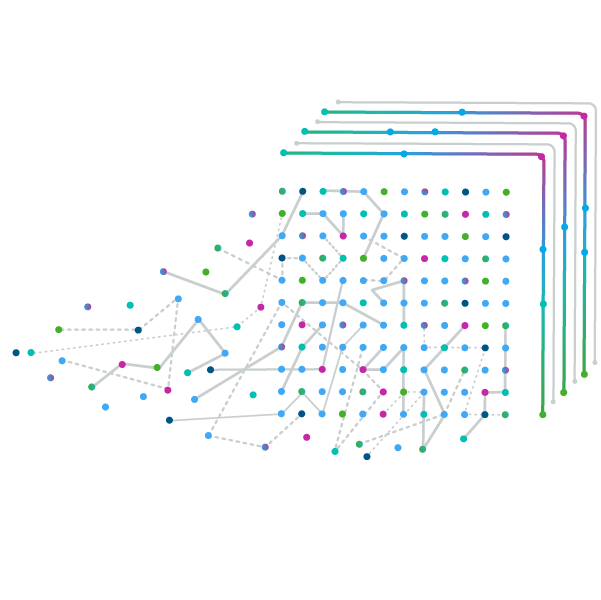Outdated compliance practices aren't viable amid evolving market and regulatory changes. IQVIA’s award-winning, end-to-end quality management system streamlines the product value chain, accelerates market entry, safeguards companies and patient safety, and meets complex regulatory demands.
Quality and regulatory teams can use generative AI to improve efficiency and performance
Artificial Intelligence (AI) technologies are increasingly integrated into various aspects of daily life, from smartphone apps to autonomous vehicles, revolutionizing industries and reshaping how humans interact with technology.
While traditional AI focuses on performing specific tasks with existing data, generative AI enables the creation of new content. Generative AI has the potential to transform how quality management (QM) and regulatory affairs (RA) tasks are done.
Global harmonization is the ideal, but most countries still have specific QM and RA requirements, and the time organizations spend on quality and regulatory work continues to increase while regulators are shortening the time in which organizations must report. Given these conditions, many life sciences companies are less confident that they can maintain compliance and keep pace with the volume of data and work. With the human resource pool shrinking, technological solutions will be needed to manage these challenges.
“There are over 101,000 global regulations and reference documents. Each year, over 8,000 new regulations and reference documents are published. That means there’s a new or changed regulation or reference document published somewhere in the world every 13 minutes.” Kari Miller, IQVIA
Generative AI is powering massive productivity gains across industries
Experts agree that generative AI tools will touch every industry, thanks to their ability to create images and video, software code, new proteins for drug discovery, and more. According to McKinsey, generative AI will add $4.4 trillion per year to the global economy.1 Organizations like Harvard, MIT, and Boston Consulting estimate that productivity gains from generative AI may be up to 60%. 2,3,4,5
Generative AI tools can deliver significant value to many quality and regulatory processes
Generative AI-powered features can be applied to a wide range of quality and regulatory work, including user training and support, research, content and code creation, personalization, translations, and more. By integrating generative AI-powered solutions into workflows, organizations can generate quality management system (QMS) and regulatory content, support users with bot assistants, and automatically classify and tag regulatory and quality information.
- QMS content generation – Generative AI can assist with content associated with audits, design control meetings and review sessions, training content, documents, and translations.
- Regulatory content generation – Promising applications of generative AI include submission document content, label authoring, and generation of consistent responses to regulatory bodies.
- Bot assistants – These tools can support eSOPs and work instructions, how-to guides, summarized instructions for power users, and user support.
- Auto-classification and tagging of regulatory and QMS information – Generative AI can read and summarize lengthy regulatory documents, auto-suggest metadata, and tags, and leverage existing ontologies and taxonomies.
AI interactions that are augmented by human knowledge can be powerful in the quality and regulatory space
AI tools can handle tedious, repetitive tasks and humans make the final decisions based on experiential knowledge.
- Improved operational efficiencies – Generative AI can decrease time and costs while executing robust processes. The technology provided a more efficient way to implement and revise quality processes.
- Faster time to market – By reducing or eliminating disjointed manual processes, generative AI minimizes unnecessary delays. As productivity increases, cycle times decrease.
- Better Quality Control – Generative AI continually improves quality by providing better training for the workforce as well as rapidly assessing and implementing changes to quality processes.
Getting started with generative AI is about balance
There will be cases where generative AI is the best tool, but there will be cases where it’s not. Ensure the technology is fit for purpose, that data governance and security is appropriate for the task and do a financial viability check to ensure the value realized from solving the problem will outrun the costs.
The generative AI powered solutions delivering the most value to QM and RA work will keep humans in the loop; support users and give them a way to manage AI, track history, customize and protect data; avoid cybersecurity risk; leverage multimodality in inputs and outputs; offer excellent user experience, deliver high-quality results, and provide real value.
Learn more about how IQVIA technologies can support your organization.
References:
- https://www.mckinsey.com/capabilities/mckinsey-digital/our-insights/the-economic-potential-of-generative-ai-the-next-productivity-frontier#key-insights
- Dell’Acqua et al. (2023) Navigating the Jagged Technological Frontier: Field Experimental Evidence of the Effects of AI on Knowledge Worker Productivity and Quality – Harvard, Boston Consulting Group, MIT
- https://www.nngroup.com/articles/ai-tools-productivity-gains/
- Sida Peng, Eirini Kalliamvakou, Peter Cihon, and Mert Demirer (2023): The Impact of AI on Developer Productivity: Evidence from GitHub Copilot
- Shakked Noy and Whitney Zhang (2023): Experimental Evidence on the Productivity Effects of Generative Artificial Intelligence. – MIT

























